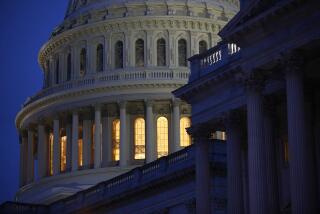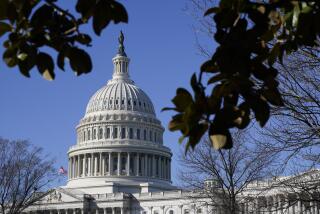A SNAPSHOT OF THE CONGRESSIONAL RACES
California has 52 congressional seats up for election this fall, seven more than two years ago, thanks to population growth, and more than any state in the nation. With new districts and irate voters, the outcomes of as many as 20 races are in doubt. That is more seats than the delegations of 46 states. Republicans expect big gains in new congressional districts, many of which cover suburban territory. But Democrats hope that this will be a Democratic year in which they can win some unexpected seats.
HERE ARE THE KEY FACTORS:
1. State reapportionment resulted in new boundaries being drawn for most congressional districts. Many incumbents lost their strongholds. Some decided not to run again, and others are struggling to build power bases on new turf.
2. Retirements and new seats have created an unprecedented 15 races in which there is no incumbent. Many of these races have brought out a new breed of candidates, and the outcome is highly uncertain.
3. If everything breaks right for GOP challengers--for instance, if there is a burst of anti-incumbent sentiment--Republicans could gain a majority of the state’s delegation to the 103rd Congress. Of the 45 seats in the current delegation, Democrats hold 26 seats and Republicans 19.
4. Democrats have fielded 17 women candidates, compared to two for the Republicans. A strong gender-based vote could be crucial in several key races. That--combined with possible trends such as Democratic coattails for the ticket headed by Bill Clinton--could neutralize GOP advantages. Democrats also hope that a number of GOP candidates will be too conservative.
The New Seats
An increase of 30 million in the state’s population meant California was awarded seven new congressional seats after the 1990 census. Several of the new districts are in Republican-leaning suburbs of the Central Valley and Southern California:
CD10 Created by the heavy influx of people into the East Bay, many of whom are Republicans.
CD11 Recognizes the high growth of Sacramento and San Joaquin counties. Leans Republican.
CD25 Represents new residents of Palmdale, Lancaster, Santa Clarita areas. Solidly Republican.
CD33 A Latino district southeast of Los Angeles. Solidly Democratic.
CD41 A 48% minority district split among Los Angeles, Orange and San Bernardino counties. Solidly Republican because of low Democratic registration.
CD43 Reflects growth in cities of Riverside and Corona. Leans heavily Republican.
CD49 Created as a result of growth along coast from La Jolla to Coronado. Unpredictable voters make it a tossup district.
Possible Upsets
Politial analysts are looking upon 1992 as a year in which nothing is certain. Public anger over the performance of Congress, the House bank scandal, the gender factor, the abortion issue, the growing power of gays and the possibility that Bill Clinton may have presidential coattails to cling to all add up to the possibility of some big political upsets. Experts cite these races. The candidate who may defy the odds and win is listed first.
CD4 Patricia Malberg (D) vs. John T. Doolittle (R inc.) 43% D -- 45% R
CD23 Anita Perez Ferguson (D) vs. Elton Gallegly (R inc.) 43% D -- 43% R
CD36 Jane Harman (D) vs. Joan Milke Flores (R) 42% D -- 44% R
CD39 Molly McClanahan (D) vs. Ed Royce (R) 39% D -- 50% R
CD43 Mark A. Takano (D) vs. Kenneth S. Calvert (R) 42% D -- 46% R
CD52 Janet M. Gastil (D) vs. Duncan Hunter (R inc.) 38% D -- 46% R
*
A
Incumbents ‘Safe Seats’
These are members of Congress who enjoy an advantage in party voter registration. In some cases they face little or no opposition and are considered virtually immune to defeat.
DEMOCRATS
CD5 Robert T. Matsui 59% D -- 30% R
CD7 George Miller 62% D -- 25% R
CD8 Nancy Pelosi 64% D -- 16% R
CD9 Ronald V. Dellums 68% D -- 15% R
CD12 Tom Lantos 55% D -- 29% R
CD13 Pete Stark 58% D -- 28% R
CD15 Norman Y. Mineta 46% D -- 39% R
CD16 Don Edwards 55% D -- 30% R
CD17 Leon E. Panetta 52% D -- 32% R
CD18 Gary A. Condit 53% D -- 36% R
CD20 Calvin Dooley 61% D -- 29% R
CD26 Howard L. Berman 59% D -- 29% R
CD29 Henry A. Waxman 57% D -- 28% R
CD31 Matthew G. Martinez 58% D -- 29% R
CD32 Julian C. Dixon 76% D -- 14% R
CD34 Esteban E. Torres 61% D -- 29% R
CD35 Maxine Waters 79% D -- 12% R
REPUBLICANS*
CD2 Wally Herger 44% D -- 42% R
CD21 Bill Thomas 42% D -- 47% R
CD27 Carlos J. Moorhead 42% D -- 45% R
CD28 David Dreier 41% D -- 48% R
CD40 Jerry Lewis 39% D -- 48% R
CD44 Al McCandless 44% D -- 45% R
CD45 Dana Rohrabacher 35% D -- 52% R
CD47 Christopher Cox 29% D -- 58% R
CD48 Ron Packard 29% D -- 56% R
CD51 Randy Cunningham 30% D -- 52% R
*
B
Non-Incumbents ‘Safe Seats’
These candidates won their primaries in districts where they have a hefty party registration advantage. Most face little opposition.
DEMOCRATS
CD30 Xavier Becerra 60% D -- 25% R
CD33 Lucille Roybal-Allard 65% D -- 21% R
CD37 Walter Tucker 76% D -- 14% R
REPUBLICANS*
CD25 Howard P. McKeon 38% D -- 50% R
CD41 Jay C. Kim 39% D -- 49% R
*
C
Candidates Likely to Win
If any of these candidates is defeated, analysts say, it would be considered an upset.
DEMOCRATS
CD6 Lynn Woolsey 54% D -- 31% R
CD50 Bob Filner 51% D -- 35% R
REPUBLICANS*
CD4 John T. Doolittle 43% D -- 45% R
CD10 Bill Baker 42% D -- 44% R
CD22 Michael Huffington 41% D -- 43% R
CD23 Elton Gallegly (inc.) 43% D -- 43% R
CD36 Joan Milke Flores 42% D -- 44% R
CD39 Ed Royce 39% D -- 50% R
CD43 Kenneth S. Calvert 42% D -- 46% R
CD46 Robert K. Dornan (inc.) 47% D -- 42% R
CD52 Duncan Hunter (inc.) 38% D -- 46% R
*
D
The Hottest Contests
CD1 Dan Hamburg (D) vs. Frank Riggs (R inc.) 52% D -- 34% R
CD3 Vic Fazio (D inc.) vs. H.L. (Bill) Richardson (R) 48% D -- 39% R
CD11 Patricia Garamendi (D) vs. Richard W. Pombo (R) 52% D -- 38% R
CD14 Anna Eshoo (D) vs. Tom Huening (R) 47% D -- 37% R
CD19 Rick Lehman (D inc.) vs. Tal L. Cloud (R) 47% D -- 42% R
CD24 Anthony C. Beilenson (D inc.) vs. Tom McClintock (R) 45% D -- 42% R
CD38 Evan Anderson Braude (D) vs. Steve Horn (R) 49% D -- 39% R
CD42 George E. Brown Jr. (D inc.) vs. Dick Rutan (R) 53% D -- 38% R
CD49 Lynn Schenk (D) vs. Judy Jarvis (R) 39% D -- 44% R
*
The Women Candidates
The current California congressional delegation has three women among its 45 members, or 7%: Barbara Boxer (D-Greenbrae), Nancy Pelosi (D-San Francisco) and Maxine Waters (D-Los Angeles). Boxer has given up her seat to run for the U.S. Senate. In the November election, 17 of the 50 Democratic candidates are women, or 34%, and two of the 49 Republican candidates are women, or 4%. Four women are in races in which women oppose each other. As many as 10 have strong chances of being elected.
DEMOCRATS
CD4 Patricia Marlberg 43% D -- 45% R
CD6 Lynn Woolsey 54% D -- 31% R
CD8 Nancy Pelosi 64% D -- 16% R
CD11 Patricia Garamendi 52% D -- 38% R
CD14 Anna Eshoo 47% D -- 37% R
CD21 Deborah Vollmer 42% D -- 47% R
CD22 Gloria Ochoa 41% D -- 43% R
CD23 Anita Perez Ferguson 43% D -- 43% R
CD33 Lucille Roybal-Allard 66% D -- 21% R
CD35 Maxine Waters 79% D -- 12% R
CD36 Jane Harman 42% D -- 44% R
CD39 Molly McClanahan 39% D -- 50% R
CD44 Gloria Smith 44% D -- 45% R
CD45 Patricia McCabe 35% D -- 52% R
CD49 Lynn Schenk 39% D -- 44% R
CD51 Bea Herbert 30% D -- 52% R
CD52 Janet M. Gastil 38% D -- 46% R
REPUBLICANS
CD36 Joan Milke Flores 42% D -- 44% R
CD49 Judy Jarvis 39% D -- 44% R
House Seats in Existing California Delegation
45 House Seats, 3 Women
50 Democratic Candidates, 17 Women
49 Republican Candidates, 2 Republican Candidates
*
Weak Spots
Political parties target or rally to incumbents who appear to be in trouble. Because of reapportionment and the possibility of a backlash against incumbents, several House members are in jeopardy.
DEMOCRATIC INCUMBENTS CONSIDERED VULNERABLE:
CD3 Vic Fazio 48% D -- 39% R
CD19 Rick Lehman 47% D -- 42% R
CD24 Anthony C. Beilenson 45% D -- 42% R
CD44 George E. Brown Jr. 53% D -- 39% R
REPUBLICAN INCUMBENT CONSIDERED VULNERABLE
CD1 Frank Riggs 52% D -- 35% R
CD23 Elton Gallegly 43% D -- 43% D
*
Best-Heeled Campaigns
California House candidates with most cash on hand **
CD28 David Dreier (R) $1,902,487
CD3 Vic Fazio (D) $815,044
CD29 Henry A. Waxman (D) $791,529
CD27 Carlos J. Moorhead (R) $736,246
CD5 Robert T. Matsui (D) $664,003
CD12 Tom Lantos (D) $658,066
CD7 George Miller (D)$ 582,885
CD13 Pete Stark (D) $555,610
CD15 Norman Y. Mineta (D) $462,653
** Latest filing with Federal Election Commission, June 30, 1992
Source: Congressional Quarterly
*
Top PAC Contributions
California House members who received the most in contributions from political action committees:
CD3 Vic Fazio (D) $658,478
CD15 Norman Y. Mineta (D) $378,928
CD29 Henry A. Waxman (D) $368,350
CD5 Robert T. Matsui (D) $283,335
CD42 George E. Brown Jr. (D) $267,186
CD19 Rick Lehman (D) $264,290
CD13 Pete Stark (D) $255,739
*
* THE REPUBLICAN FACTOR
Traditional wisdom in California holds that a district is a tossup when Democratic registration is less than 52% and GOP registration is less than 37%. Because GOP voters tend to be loyal and Democrats are more likely to cross over, a district is considered to be safely Republican when it has more than 43% of the registered voters. Likewise, a safe margin for Democrats is about 56%. Incumbents with less favorable numbers have often made up for that with the so-called “incumbent advantage.” Because of the unusual political instability this year, this wisdom may not hold.
Source: Registration figures from secretary of state’s office as of September.
More to Read
Get the L.A. Times Politics newsletter
Deeply reported insights into legislation, politics and policy from Sacramento, Washington and beyond. In your inbox three times per week.
You may occasionally receive promotional content from the Los Angeles Times.






